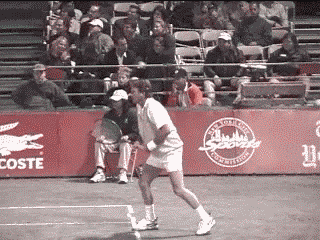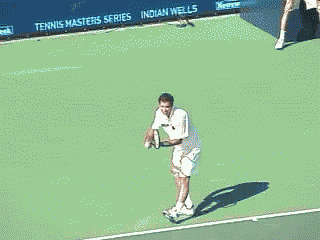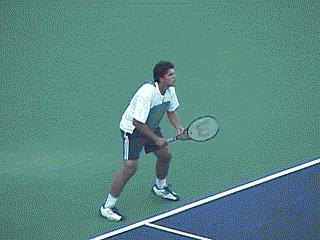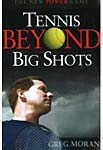| TennisOne Lessons Who's Afraid of the Big Bad Server? Greg Moran For years, players with big serves have been able to use their weapon to win easy points and intimidate opponents. However, as the game has evolved players such as Jimmy Connors, Andre Agassi, the Williams sisters and many others have turned the tide and made the return of serve an equally potent weapon. You can too.
At the recreational level you could easily face serves at speeds of 85 mph or higher. At this pace, you have a little over half a second to determine where the serve is going, if and how it’s spinning, and then execute a quality return. That’s not a lot of time but with the right approach you too can make your return of serve a weapon. Develop a return of serve ritual As with the serve, a return of serve ritual will help you relax, focus and prepare to hit your best return. Again, a ritual is a very personal thing. Here’s what I do before every point:
This simple routine helps me clear my head and allows me to mentally prepare for the next point. Where to stand The players with the strongest returns are those that can take the ball early. By doing so, they’re able to use the server’s speed against them. With that in mind, as you prepare to receive serve, ask yourself two questions:
Initially, line up as close to (or inside of) the baseline as possible with the goal of taking the ball early. In terms of how far over you should be, take your cues from the server. An experienced server will vary his or her positions along the baseline. You should as well. If the server moves more towards the center of their court, move towards yours. If he moves out wide, slide over to cut off the probable angle. Many players will serve to the same spot time after time while others will give you a clue as to where they’re serving by how they stand or where they toss the ball. For example, if the toss is to the left of the server’s body, move to your left. If he tosses the ball wide to his right side, move to your right. As the match progresses, take note of the server’s strengths and tendencies and adjust your position (up or back, and left or right) accordingly As you wait for the serve, I suggest holding the grip that you use for your weakest groundstroke. If you usually struggle with your backhand return, wait with your backhand grip. That way, if the serve comes to your backhand side you have a bit of a head start. Be up on your toes and, based on the server’s style of play, have a general idea of what you want to do with your return. If you’re facing a serve and volley opponent, focus on returning the ball down low at their feet, hoping to make them pop the ball up. If you’re opponent serves and stays back, plan on aiming 2-3 feet above the net, return the ball crosscourt and deep and then get into the rally. The Spit-Step The split-step gets little attention but I feel it is, initially, the most important thing a high level player can do in terms of stroke production. This is particularly vital when returning high speed serves. With a well-timed split-step, you’ll get a quick first step towards the ball. Without it, you’ll forever be playing catch up.
As always, time your split-step so that you are in the air as your opponent strikes the ball. As you come down, and have seen where the serve is going, turn your foot that is closest to the oncoming serve towards the ball. This allows you to actually begin moving to the shot before you actually touch the court. At the same time, begin your shoulder and racquet preparation. As the ball approaches, move diagonally forward and strike the ball just before it reaches the peak of its bounce. Against the big serves, focus on placement, not power. The momentum of your body moving into the shot will provide all the power you’ll need. Hard as it is to believe, many players forget that their priority with the return of serve is to return the serve. You can’t win the point if you don’t return the ball and even the shortest weakest return is better than an error. Do not attempt to tee off and go for an outright winner. Very rarely will you be able to end the point with your return of serve. Here are a few strategies to choose from as your opponent prepares to serve: First Serve Return Strategies When facing a powerful first serve, your goal is to react quickly and neutralize your opponent’s advantage. Nothing takes the wind out of a big server’s sails faster than an opponent who shows no fear and can spit their big serve right back at them. Here are a few ideas on how to do just that.
Second Serve Strategies When you listen to tennis commentary you’ll notice that the announcers always stress the importance of first server percentage. That’s because the player serving has the advantage on the first serve but when that first serve is missed, the advantage shifts firmly to the receiver. When facing a second serve, you know that, in all probably it will be weaker than the first which means that you can now shift attack mode. Move three feet forward and two steps to the left or right favoring your favorite shot. This will tell the server that you’re going to hit your strongest shot after they’ve hit their weakest serve. Here are three strategies to consider the next time your opponent hands you the gift of a second serve.
Adopt a “bring it on” attitude when receiving serve and show your opponent that you’re not afraid of the power. Strive to get every serve back in play and take advantage of weak second serves. The serve is many players biggest weapon and if you can take away that weapon with consistent, aggressive returns you’ll take away their heart and be well on your way to victory. Your comments are welcome. Let us know what you think about Greg Moran's article by emailing us here at TennisOne.
Tennis Beyond Big Shots presents a bold back-to-the-future approach. A new game that moves away from power and big shots yet is more lethal to opponents than any booming serve. Greg Moran shows players of all ages and abilities that, with simple and small changes, you can not only maximize your tennis wins and play longer, but also have much more fun doing it. Click link to purchase Greg Moran's book, Tennis Beyond Big Shots. Mansion Grove House is pleased to announce that in May, 2008, they will release the second edition of Tennis Beyond Big Shots. Written by Greg Moran, the book (which includes a new chapter) was Amazon's #1 new tennis release in 2007. |


 Taylor Dent puts pressure on his opponent's second serve with a classic chip and charge pattern.
Taylor Dent puts pressure on his opponent's second serve with a classic chip and charge pattern.